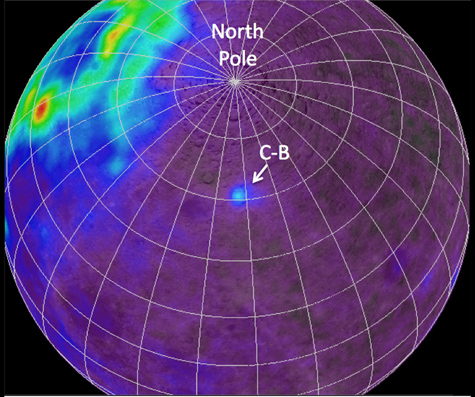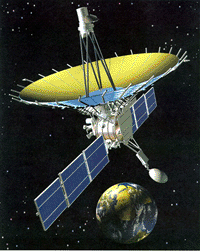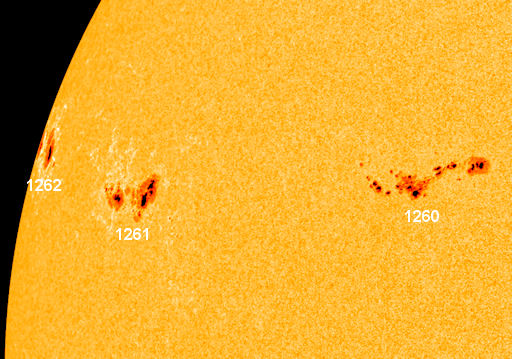7.30.2011
Dawn's Spacecraft Views Dark Side of Vesta
Dawn took this image over Vesta's northern hemisphere after the spacecraft completed its first passage over the dark side of the giant asteroid. It is northern hemisphere winter on Vesta now, so its north pole is in deep shadow.
The Dawn science team is working to determine the significance of the distinct features in this image, which include large grooves or ridges extending for great distances around Vesta.
This image was taken by Dawn's framing camera on July 23, from a distance of 3,200 miles (5,200 kilometers).
What lies inside Jupiter?
Jupiter's swirling clouds can be seen through any department store telescope. With no more effort than it takes to bend over an eyepiece, you can witness storm systems bigger than Earth navigating ruddy belts that stretch hundreds of thousands of kilometers around Jupiter's vast equator. It's fascinating.
It's also vexing. According to many researchers, the really interesting things--from the roots of monster storms to stores of exotic matter--are located at depth. The clouds themselves hide the greatest mysteries from view.
NASA's Juno probe, scheduled to launch on August 5th, could change all that. The goal of the mission is to answer the question, What lies inside Jupiter?
It's also vexing. According to many researchers, the really interesting things--from the roots of monster storms to stores of exotic matter--are located at depth. The clouds themselves hide the greatest mysteries from view.
NASA's Juno probe, scheduled to launch on August 5th, could change all that. The goal of the mission is to answer the question, What lies inside Jupiter?
7.28.2011
BIG SUNSPOTS
NOAA forecasters estimate a 40% chance of M-class solar flares today. The source would be one of three big sunspots emerging along the sun's northeastern limb. Click on the image to view a 3-day movie from NASA's Solar Dynamics Observatory:
Among the three, the leading sunspot AR1260 is most active. It has produced more than a dozen C-class flares in the past 24 hours, more than doubling the total for the entire month of July so far. New sunspot AR1262, however, could eventually cause more trouble. Magnetograms of the active region reveal a delta-class magnetic field that harbors energy for powerful X-class eruptions.
A solar flare is an explosion on the Sun that happens when energy stored in twisted magnetic fields (usually above sunspots) is suddenly released. Flares produce a burst of radiation across the electromagnetic spectrum, from radio waves to x-rays and gamma-rays.
Scientists classify solar flares according to their x-ray brightness in the wavelength range 1 to 8 Angstroms. There are 3 categories: X-class flares are big; they are major events that can trigger planet-wide radio blackouts and long-lasting radiation storms. M-class flares are medium-sized; they can cause brief radio blackouts that affect Earth's polar regions. Minor radiation storms sometimes follow an M-class flare. Compared to X- and M-class events, C-class flares are small with few noticeable consequences here on Earth.
DISINTEGRATING COMET
On July 5th, a comet dove into the sun and disintegrated. New footage just released by NASA shows the final stages of the comet's death plunge.
more: here
more: here
Unseen comet's orbit indicates possible crash
 |
| Credit: NASA |
A stream of dusty fragments from a comet born in the outermost reaches of the solar system has hit the Earth on a path that leads astronomers to conclude the comet itself could be "potentially hazardous" if it crashes into the planet.
The comet's location is unknown, making it difficult to say when it will approach Earth, but "the orbits of the dust trail tells us that the comet is on a path that could eventually hit us," said Peter Jenniskens, an astronomer at the SETI Institute and the NASA Ames Research Center in Mountain View.
7.27.2011
China launches 9th Beidou-2 satellite
Yesterday 26th July, China has launched the ninth satellite of its Beidou-2 national orbital navigation system from the Sichuan Province’s spaceport. Efforts to create an alternative to America’s GPS and Russia’s GLONASS constellations began in 2007.
The new system will include a total of 35 satellites providing navigation services across the Asia-Pacific Region from 2012 and then switching to global coverage in 2020.
Sun becoming very active
The Sun popped off no less than five coronal mass ejections over three-days (July 19-22, 2011). While none of them appeared very strong, they do suggest that the level of solar activity is increasing...
Today th 27th July , several CME were detected.
Today th 27th July , several CME were detected.
Huge meteorite found in China

A big stony-iron meteorite has been found in Altay prefecture of Xinjiang Uygur autonomous region, China.
The above-earth part of the rock is 2.2-metre long and 1.25-metre tall, with a width of 1.2-metre.
Its weight is estimated at 25 tonnes (25,401kg), at least.
Animation of Mars Science Laboratory Mission
Animation of the Mars Science Laboratory from entry, descent and landing phase to surface operation.
The Mars Science Laboratory is a NASA mission with the aim to land and operate a rover named Curiosity on the surface of Mars. Is scheduled to launch between November 25 and December 18, 2011 and to land on Mars at Gale crater between August 6 and August 20, 2012.
The Mars Science Laboratory is a NASA mission with the aim to land and operate a rover named Curiosity on the surface of Mars. Is scheduled to launch between November 25 and December 18, 2011 and to land on Mars at Gale crater between August 6 and August 20, 2012.
7.25.2011
How to Explore an Asteroid
 |
| Artist's concept of anchoring to the surface of an asteroid. Image credit: NASA |
The next big new mission for NASA may well be going to an Asteroid. To determine how best to explore asteroids in the future, NASA scientists and engineers are taking their experiments underwater in the 15th expedition of NASA Extreme Environment Mission Operations, or NEEMO.
Unique volcanic complex discovered on Moon’s far side
 |
NASA/GSFC/ASU/WUSTL, processing by B. Jolliff Map of the abundance of the element thorium on the Moon made with data from the Lunar Prospector, a space mission launched in 1998, shows that most of this radioactive element is concentrated in a region on the Moon's near side (left). But there is also a small hot spot called the Compton-Belkovich Thorium Anomaly (labeled C-B in the map) on the side of the Moon that faces away from Earth. |
New Russian carrier rockets to the Moon
 |
| N-1 Rocket . When Soviet Union try to reach the moon with a manned program. |
Russia is working on two large-scale space projects simultaneously, including the next generation of the “Soyuz” spaceships and a principally new space system with the Rus-M carrier rocket. The launching pad for it will be built in the Far East. In the future it will be possible to carry out manned flights to the Moon from there.
7.24.2011
A Gun in Space
 |
| Salyut 3 |
Spectrum-R Mirror Deployed
Orbital operations with Russian astrophysical observatory Spectrum-R which had been launched from Baikonur on July 18 continue successfully. Radiotelescope mirror has been successfully deployed on July 23.
According to telemetry data obtained in Lavochkin R&D, the scheduled operations are carried out in full scope.

Spectrum-R, developed under Radioastron project in the framework of Russian Federal Space Program, is intended to study the Universe. The aim of the mission is to use the space telescope to conduct interferometer observations in conjunction with the global ground radio telescope network in order to obtain images, coordinates, motions and evolution of angular structure of different radio emitting objects in the Universe. Scientists also expect to obtain more information about pulsars and interstellar plasma, black holes and neutron stars in the Milky Way. The spacecraft's operational lifetime will be no less than five years.
According to telemetry data obtained in Lavochkin R&D, the scheduled operations are carried out in full scope.

Spectrum-R, developed under Radioastron project in the framework of Russian Federal Space Program, is intended to study the Universe. The aim of the mission is to use the space telescope to conduct interferometer observations in conjunction with the global ground radio telescope network in order to obtain images, coordinates, motions and evolution of angular structure of different radio emitting objects in the Universe. Scientists also expect to obtain more information about pulsars and interstellar plasma, black holes and neutron stars in the Milky Way. The spacecraft's operational lifetime will be no less than five years.
7.23.2011
NASA Tests Future Deep Space Vehicle For Water Landings
As NASA closes the chapter on the Space Shuttle Program, a new era of exploration vehicles is beginning to take off.
Testing began this month at NASA's Langley Research Center in Hampton, Va., in the new Hydro Impact Basin to certify the Orion Multi-Purpose Crew Vehicle (MPCV) for water landings. The Orion MPCV will carry astronauts into space, provide emergency abort capability, sustain the crew during space travel and ensure safe re-entry and landing.
 |
| Hydro Impact Basin (HIB) Orion Multi-Purpose Crew Vehicle (MPCV) Boilerplate Test Article (BTA) drop test from July 21, 2011. Credit: NASA/Sean Smith |
Testing began this month at NASA's Langley Research Center in Hampton, Va., in the new Hydro Impact Basin to certify the Orion Multi-Purpose Crew Vehicle (MPCV) for water landings. The Orion MPCV will carry astronauts into space, provide emergency abort capability, sustain the crew during space travel and ensure safe re-entry and landing.
7.22.2011
Astronomers Find Largest, Most Distant Reservoir of Water
 |
| This artist's concept illustrates a quasar, or feeding black hole, similar to APM 08279+5255, where astronomers discovered huge amounts of water vapor. Image credit: NASA/ESA |
Two teams of astronomers have discovered the largest and farthest reservoir of water ever detected in the universe. The water, equivalent to 140 trillion times all the water in the world's ocean, surrounds a huge, feeding black hole, called a quasar, more than 12 billion light-years away.
Next Mars Rover to Land at Gale Crater
 |
| This computer-generated view based on multiple orbital observations shows Mars' Gale crater as if seen from an aircraft northwest of the crater. Image credit: NASA/JPL-Caltech/ASU/UA |
NASA's next Mars rover will land at the foot of a layered mountain inside the planet's Gale crater.
The car-sized Mars Science Laboratory, or Curiosity, is scheduled to launch late this year and land in August 2012. The target crater spans 96 miles (154 kilometers) in diameter and holds a mountain rising higher from the crater floor than Mount Rainier rises above Seattle. Gale is about the combined area of Connecticut and Rhode Island. Layering in the mound suggests it is the surviving remnant of an extensive sequence of deposits. The crater is named for Australian astronomer Walter F. Gale.
Leonid Elenin Discovered a new comet , P/2011 N01
A Photo from the Messenger of Mercury
 |
| Credit: NASA/Johns Hopkins University Applied Physics Laboratory/Carnegie Institution of Washington |
Date acquired: June 26, 2011
Image ID: 0217604449, 0217604465, 0217604445
Instrument: Wide Angle Camera (WAC) of the Mercury Dual Imaging System (MDIS)
WAC filter: 9 (1000 nanometers), 7 (750 nanometers), 6 (430 nanometers) as red-green-blue
Center Latitude: -19.31°
Center Longitude: 187.7° E
Resolution: 1385 meters/pixel
Highlighted in this image are Basho, the dark-haloed crater at the bottom of this scene, Kalidasa crater, the bright crater near the center, along with Tolstoj basin on the right, in beautiful color. Many different types of surface materials are found in this region, including crater rays, low reflectance material (LRM), and smooth plains (within Tolstoj).
This image was acquired as part of MDIS's color base map. The color base map is composed of WAC images taken through eight different narrow-band color filters and will cover more than 90% of Mercury's surface with an average resolution of 1 kilometer/pixel (0.6 miles/pixel). The highest-quality color images are obtained for Mercury's surface when both the spacecraft and the Sun are overhead, so these images typically are taken with viewing conditions of low incidence and emission angles.
The MESSENGER spacecraft is the first ever to orbit the planet Mercury, and the spacecraft's seven scientific instruments and radio science investigation are unraveling the history and evolution of the Solar System's innermost planet. During the one-year primary mission, MDIS is scheduled to acquire more than 75,000 images in support of MESSENGER's science goals.
source: NASA
7.21.2011
Atlantis Completes Final Space Shuttle Program Landing
 |
| Image above: Space shuttle Atlantis lands for the final time at NASA’s Kennedy Space Center in Florida. Photo credit: NASA TV |
At 5:57 a.m. EDT, space shuttle Atlantis landed for the final time at NASA’s Kennedy Space Center after 200 orbits around Earth and a journey of 5,284,862 miles on STS-135.
It was the 25th night landing, the 78th landing at Kennedy and the133rd landing in shuttle history.
Minor Planets Disrupt Earth's Orbit
Long-term simulations show that close encounters between the minor planets Ceres and Vesta could affect the Earth's orbit.
| Numerical simulations of the long-term evolution of the orbits of minor planets Ceres and Vesta, which are the largest bodies in the asteroid belt between Mars and Jupiter, have found that close encounters among these bodies lead to strong chaotic behavior of their orbits, as well as of the Earth's eccentricity. This means that the Earth's past orbit cannot be reconstructed beyond 60 million years. Studying the interactions between the Earth and the solar system environment can help astrobiologists understand the conditions that make Earth habitable for life, and the future that could be in store for our planet's biosphere. |
7.20.2011
New Moon Around Pluto discovered by Hubble
Astronomers using the Hubble Space Telescope have discovered a fourth moon orbiting the icy dwarf planet Pluto. The tiny, new satellite – temporarily designated P4 - popped up in a Hubble survey searching for rings around the dwarf planet.
The new moon is the smallest discovered around Pluto. It has an estimated diameter of 8 to 21 miles (13 to 34 km). By comparison, Charon, Pluto's largest moon, is 648 miles (1,043 km) across, and the other moons, Nix and Hydra, are in the range of 20 to 70 miles in diameter (32 to 113 km).
The new moon is the smallest discovered around Pluto. It has an estimated diameter of 8 to 21 miles (13 to 34 km). By comparison, Charon, Pluto's largest moon, is 648 miles (1,043 km) across, and the other moons, Nix and Hydra, are in the range of 20 to 70 miles in diameter (32 to 113 km).
Spectrum R reached Orbit
Subscribe to:
Posts (Atom)






